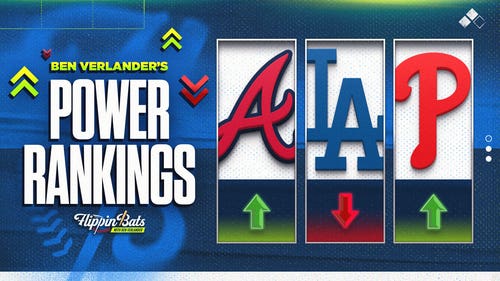





































































































































FOX brings 'Moneyball' stats to ALCS
“Moneyball” on FOX? Well, not quite. Billy Beane will not join Joe Buck in the broadcast booth. Neither, for that matter, will Brad Pitt.
But FOX, using technology from Bloomberg Sports, will make new use of the advanced statistics depicted in the recent film “Moneyball” during its coverage of both the American League Championship Series and World Series.
And it’s going to be fun stuff.
Want to know how the Rangers’ Josh Hamilton fares against a 95-mph-plus fastball? The swing-and-miss percentage of hitters against Tigers right-hander Justin Verlander with two strikes? The chances of the Rangers’ Ian Kinsler getting on base on an 2-1 count against Tigers righty Max Scherzer with the score tied in the sixth inning?
FOX will be ready with graphics for all that and more.
"We are always looking for new angles and insights to enhance our presentation of the game. We have so many cameras and angles for replays, but this new technology is like showing a pre-play,’’ said Eric Shanks, president of FOX Sports.
"We now have the ability to make a reasonable prediction for what's going to happen."
Bloomberg has assembled pitch-by-pitch data dating to 2006 — and other raw statistics going back to before 1900 — that will form the basis of the analytics that appear on screen.
Perhaps the most interesting new wrinkle will be a tracker that shows on-base percentage odds as they change with every pitch — the type of innovation that helped popularize televised poker, bringing the predictive nature of the sport to life.
“With each pitch, we will be recalculating the odds of the batter reaching base, based on the specific matchup, the ballpark in question and the circumstances of men on base and the inning,” said Bill Squadron, the head of Bloomberg Sports.
Say Hamilton is facing Verlander. When the count is 0-0, the odds of reaching base might be 28 percent. Then Verlander throws a strike and the number drops to 18 percent. If he had thrown a ball, it might have shot up to 36 percent.
The information will be displayed at the bottom of the screen in simple fashion: “Reach base: 36 percent.”
“The one I am excited about is the on-base predictor,” Shanks said. “Everyone is ‘hoping’ for their team’s players to get on base in clutch situations. But we usually don’t know how clutch the situation is.
“There are enough stats being collected on every pitch that we can now use those historical, matchup-based stats to show exactly that. And after every pitch the odds of him getting on base will change.
“ 'Holy smoke, he only has a 30 percent chance of getting on base? C’mon man, you can do it.’ People learned to respect the skills of poker players when the odds were against them and they won. I think this will do the same thing.”
It goes back to the original idea of sabermetrics: To better understand the sport through objective, empirical evidence, specifically statistics that measure in-game activity.
As with everything in baseball, the new stats figure to appeal to different fans in different ways. Casual fans should enjoy the poker-style odds. The sabermetically inclined will relish the inside-the-game element. Fans of the Rangers and Tigers will gain new insight on their favorite teams.
“Anything that makes the game more interesting, or helps spark more conversation in a bar or living room, is great for the game,” Squadron said. “You want things that enhance the experience and are valuable for people. You don’t want to just use the data for its own sake.”
But the data is now the lifeblood of the game.
Baseball’s statistical revolution, as popularized by author Michael Lewis' book, “Moneyball: The Art of Winning an Unfair Game,” included an increased emphasis on what the financial market calls “derivatives” — seemingly arcane pieces of information that had a distinct, quantifiable value.
Information that, when pieced together, gave teams a more objective insight into a player’s performance.
Information such as a hitter’s chase rate — the percentage of pitches that he swings at outside of the strike zone.
“Look at the interest in ‘Moneyball,’ ” Squadron said. “People want to know what goes on in managerial decisions, what players are thinking about and looking for. With this, we’re giving them access to the same kind of data that the pros are using.”
Who needs Brad Pitt or even Billy Beane?

2024 MLB Power Rankings: Who deserves No. 1 spot as Dodgers tumble?

Brewers' Jakob Junis hit by fly ball in batting practice, taken away in ambulance

DJ LeMahieu leaves 1st minor league rehab game in 2nd inning with sore right foot

20 Best pitchers in MLB 2024: Ranking the top 20 starters

Yankees' Aaron Boone ejected five pitches into game vs. A's after fan outburst


2024 MLB Power Rankings: Who deserves No. 1 spot as Dodgers tumble?

Brewers' Jakob Junis hit by fly ball in batting practice, taken away in ambulance

DJ LeMahieu leaves 1st minor league rehab game in 2nd inning with sore right foot

20 Best pitchers in MLB 2024: Ranking the top 20 starters

Yankees' Aaron Boone ejected five pitches into game vs. A's after fan outburst
